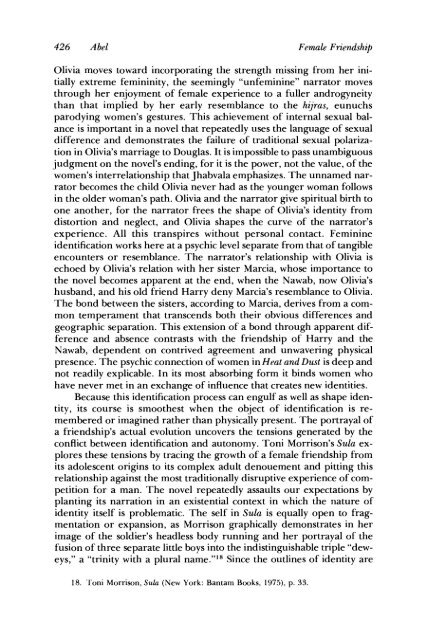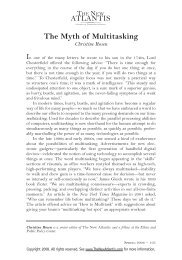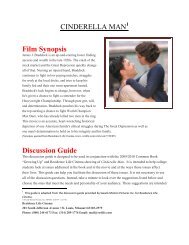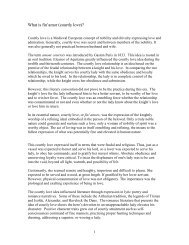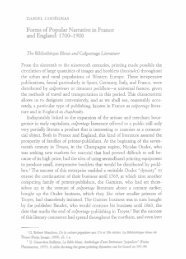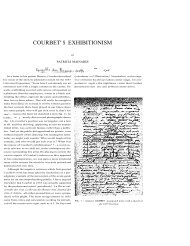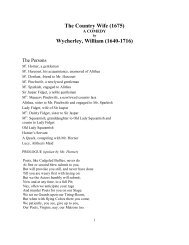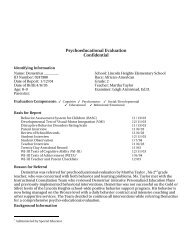(E)Merging Identities: The Dynamics of Female Friendship in ...
(E)Merging Identities: The Dynamics of Female Friendship in ...
(E)Merging Identities: The Dynamics of Female Friendship in ...
Create successful ePaper yourself
Turn your PDF publications into a flip-book with our unique Google optimized e-Paper software.
426 Abel <strong>Female</strong> <strong>Friendship</strong><br />
Olivia moves toward <strong>in</strong>corporat<strong>in</strong>g the strength miss<strong>in</strong>g from her <strong>in</strong>itially<br />
extreme fem<strong>in</strong><strong>in</strong>ity, the seem<strong>in</strong>gly "unfem<strong>in</strong><strong>in</strong>e" narrator moves<br />
through her enjoyment <strong>of</strong> female experience to a fuller androgyneity<br />
than that implied by her early resemblance to the hijras, eunuchs<br />
parody<strong>in</strong>g women's gestures. This achievement <strong>of</strong> <strong>in</strong>ternal sexual balance<br />
is important <strong>in</strong> a novel that repeatedly uses the language <strong>of</strong> sexual<br />
difference and demonstrates the failure <strong>of</strong> traditional sexual polarization<br />
<strong>in</strong> Olivia's marriage to Douglas. It is impossible to pass unambiguous<br />
judgment on the novel's end<strong>in</strong>g, for it is the power, not the value, <strong>of</strong> the<br />
women's <strong>in</strong>terrelationship that Jhabvala emphasizes. <strong>The</strong> unnamed narrator<br />
becomes the child Olivia never had as the younger woman follows<br />
<strong>in</strong> the older woman's path. Olivia and the narrator give spiritual birth to<br />
one another, for the narrator frees the shape <strong>of</strong> Olivia's identity from<br />
distortion and neglect, and Olivia shapes the curve <strong>of</strong> the narrator's<br />
experience. All this transpires without personal contact. Fem<strong>in</strong><strong>in</strong>e<br />
identification works here at a psychic level separate from that <strong>of</strong> tangible<br />
encounters or resemblance. <strong>The</strong> narrator's relationship with Olivia is<br />
echoed by Olivia's relation with her sister Marcia, whose importance to<br />
the novel becomes apparent at the end, when the Nawab, now Olivia's<br />
husband, and his old friend Harry deny Marcia's resemblance to Olivia.<br />
<strong>The</strong> bond between the sisters, accord<strong>in</strong>g to Marcia, derives from a common<br />
temperament that transcends both their obvious differences and<br />
geographic separation. This extension <strong>of</strong> a bond through apparent difference<br />
and absence contrasts with the friendship <strong>of</strong> Harry and the<br />
Nawab, dependent on contrived agreement and unwaver<strong>in</strong>g physical<br />
presence. <strong>The</strong> psychic connection <strong>of</strong> women <strong>in</strong> Heat and Dust is deep and<br />
not readily explicable. In its most absorb<strong>in</strong>g form it b<strong>in</strong>ds women who<br />
have never met <strong>in</strong> an exchange <strong>of</strong> <strong>in</strong>fluence that creates new identities.<br />
Because this identification process can engulf as well as shape identity,<br />
its course is smoothest when the object <strong>of</strong> identification is remembered<br />
or imag<strong>in</strong>ed rather than physically present. <strong>The</strong> portrayal <strong>of</strong><br />
a friendship's actual evolution uncovers the tensions generated by the<br />
conflict between identification and autonomy. Toni Morrison's Sula explores<br />
these tensions by trac<strong>in</strong>g the growth <strong>of</strong> a female friendship from<br />
its adolescent orig<strong>in</strong>s to its complex adult denouement and pitt<strong>in</strong>g this<br />
relationship aga<strong>in</strong>st the most traditionally disruptive experience <strong>of</strong> competition<br />
for a man. <strong>The</strong> novel repeatedly assaults our expectations by<br />
plant<strong>in</strong>g its narration <strong>in</strong> an existential context <strong>in</strong> which the nature <strong>of</strong><br />
identity itself is problematic. <strong>The</strong> self <strong>in</strong> Sula is equally open to fragmentation<br />
or expansion, as Morrison graphically demonstrates <strong>in</strong> her<br />
image <strong>of</strong> the soldier's headless body runn<strong>in</strong>g and her portrayal <strong>of</strong> the<br />
fusion <strong>of</strong> three separate little boys <strong>in</strong>to the <strong>in</strong>dist<strong>in</strong>guishable triple "deweys,"<br />
a "tr<strong>in</strong>ity with a plural name."'8 S<strong>in</strong>ce the outl<strong>in</strong>es <strong>of</strong> identity are<br />
18. Toni Morrison, Sula (New York: Bantam Books, 1975). p. 33


